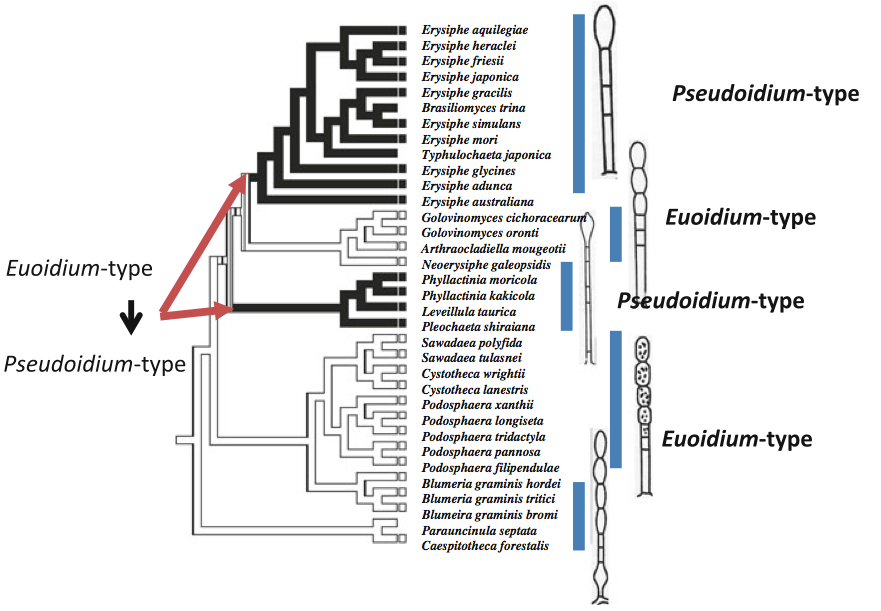After establishing itself on a host a powdery mildew can begin to reproduce. Asexual conidia (spores) are produced as 3-D protrusions, on structures called conidiophores, from the predominantly 2-D mycelial network on the surface of a host.
In this aspect of morphology/biology powdery mildews are separated into two distinct groups: those producing a single conidia per conidiophore per day (pseudoidium-type); and those producing many (euoidium-type) (fig. 1).

Figure 1: Conidiogenesis types. Pseudoidium-types, comprised of the tribes Erysipheae and Phyllactineae, produce false chains with just a single conidium at its apex which is released daily. Euoidium-types, comprised of the remaining three tribes (Blumerieae, Cystotheceae and Golovinomyceteae), produce many conidia per day in true chains. (From Takamatsu, 2013)
Fungi are known for their highly virile nature: producing thousands of spores per minute. with a typically low investment per spore resulting in a similarly low number of these finding a suitable environment to extend its life.
The seemingly more complex multiple spore producing euodium-type has been shown to be the ancestral form from which the pseudoidium-type arose on at least two separate occasions (Mori et al., 2000) (fig. 2).

Figure 2: Molecular phylogenetic tree of the powdery mildews inferred from the combined data set of the 18S, 28S and 5.8S rDNA sequences. White and black branches indicate species of Euoidium-type and Pseudoidium-type, respectively. (From Takamatsu, 2013).
This pathway to a more simple method of spore release shows a devolution of a morphological character. Such a move towards simplicity is also seen in the appendages sexual spores use to latch onto host structures…
References:
Mori Y, Sato Y, Takamatsu S (2000) Evolutionary analysis of the powdery mildew fungi using nucleotide sequences of the nuclear ribosomal DNA. Mycologia 92:74–93
Takamatsu, S (2013). Molecular phylogeny reveals phenotypic evolution of powdery mildews (Erysiphales, Ascomycota). Journal of General Plant Pathology: 1-9.

Pingback: Appendage Morphology | Culham Research Group
Pingback: Sexual Fungi | Culham Research Group
Pingback: Where it all began… | Culham Research Group
Pingback: Powdery mildew morphological glossary | Culham Research Group